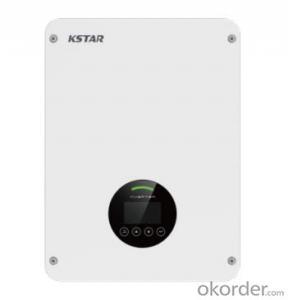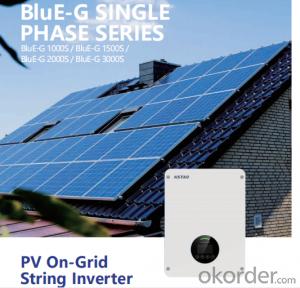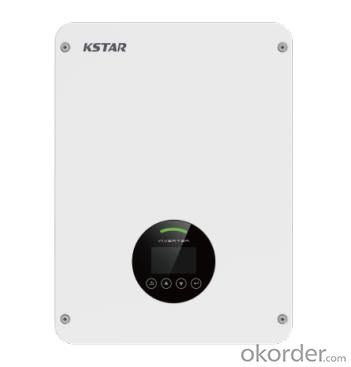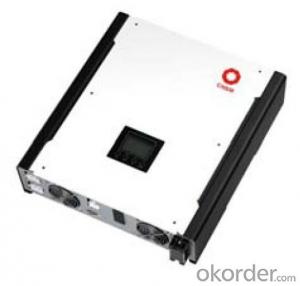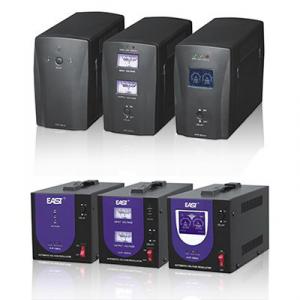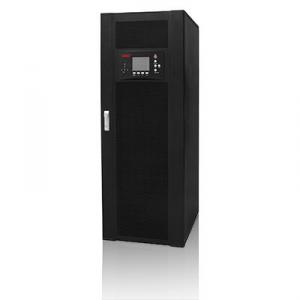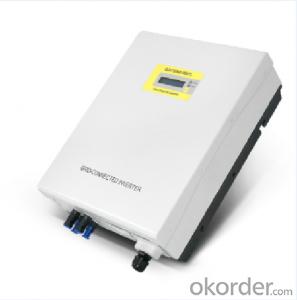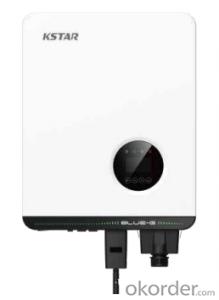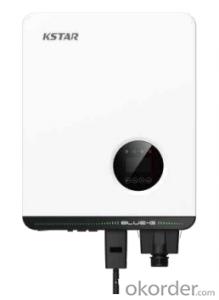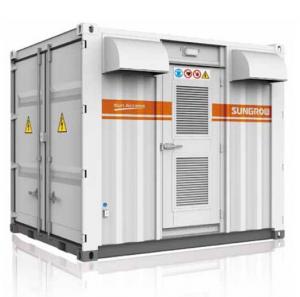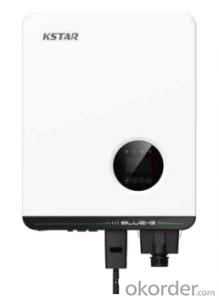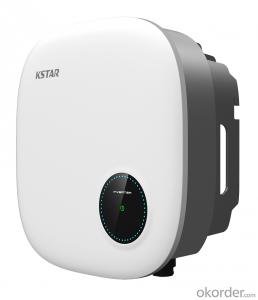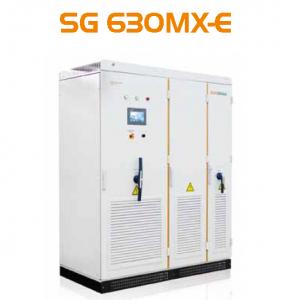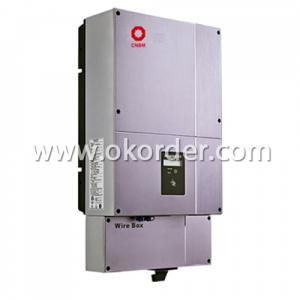PWM Solar Inverter PV On-Grid String Inverter Blue-G 1000S / Blue-G 1500S / Blue-G 2000S / Blue-G 3000S
- Loading Port:
- China main port
- Payment Terms:
- TT OR LC
- Min Order Qty:
- 50 pc
- Supply Capability:
- 15000 pc/month
OKorder Service Pledge
OKorder Financial Service
You Might Also Like
Specification
Product Description:
★Max. PV voltage up to 600V DC/AC ratio up to 1.5
★High efficiency up to 97.6% Smaller and lighter
★Type II DC SPD/Type III AC SPD IP65 protection
★Compatible for big capacity PV panel WiFi / 4G Plug optional
| MODEL | BluE-G 1000S | BluE-G 1500S | BluE-G 2000S | BluE-G 3000S |
| Input(DC) | ||||
| Max. DC voltage | 600Vdc | 600Vdc | 600Vdc | 600Vdc |
| Nominal voltage | 380Vdc | 380Vdc | 380Vdc | 380Vdc |
| Start voltage | 80V | 80V | 80V | 80V |
| MPPT voltage range | 80V-560V | 80V-560V | 80V-560V | 80V-560V |
| Number of MPP tracker | 1 | 1 | 1 | 1 |
| Strings per MPP tracker | 1 | 1 | 1 | 1 |
| Max. input current per MPPT | 15A | 15A | 15A | 15A |
| Max. short-circuit current per MPPT | 18A | 18A | 18A | 18A |
| Output(AC) | ||||
| Nominal AC output power | 1000W | 1500W | 2000W | 3000W |
| Max. AC apparent power | 1000VA | 1650VA | 2200VA | 3300VA |
| Nominal AC voltage | 230V L-N | 230V L-N | 230V L-N | 230V L-N |
| AC grid frequency range | 50Hz / 60Hz±5Hz | 50Hz / 60Hz±5Hz | 50Hz / 60Hz±5Hz | 50Hz / 60Hz±5Hz |
| Max. Output Current (A) | 4.8A | 7.2A | 9.6A | 14.4A |
| Power factor (cos ) | 0.8 leading to 0.8 lagging | |||
| THDi | <3% | |||
| Efficiency | ||||
| Max. efficiency | 97.00% | 97.50% | 97.50% | 97.60% |
| Euro efficiency | 96.50% | 97.00% | 97.00% | 97.00% |
| Protection devices | ||||
| DC switch | Yes | Yes | Yes | Yes |
| Anti-islanding protection | Yes | Yes | Yes | Yes |
| Output over current | Yes | Yes | Yes | Yes |
| DC reverse polarity protection | Yes | Yes | Yes | Yes |
| String fault Detection | Yes | Yes | Yes | Yes |
| Surge protection | DC Type III;AC Type III | |||
| Insulation detection | Yes | Yes | Yes | Yes |
| AC short circuit protection | Yes | Yes | Yes | Yes |
| General Specifications | ||||
| Dimensions W x H x D (mm) | 350*290*120mm | |||
| Weight(kg) | 7.3kg | 8kg | 8kg | 8kg |
| Environment | ||||
| Operating temperature range | –25℃~+60℃ | |||
| Cooling type | Natural | |||
| Max. operation altitude | 4000m | |||
| Max. operation humidity | 0-100% | |||
| AC Output terminal type | Quick connector | |||
| Topology | IP65 | |||
| IP class | Transformer-less | |||
| Communication Interface | RS485/WIFI/4G | |||
| Display | LCD | |||
| Certification & Standard | EN/IEC62109-1/2;IEC/EN61000-6-2;IEC/EN61000-6-4;IEC62116;IEC61727;EN50549-1 | |||
FAQ:
Q:How the output voltage of the PV inverter and the grid-connected voltage are determined
Inverter is the DC power (battery, battery) into alternating current (usually 220V, 50Hz sine wave). It consists of inverter bridge, control logic and filter circuit. Widely used in air conditioning, home theater, electric wheel, power tools, sewing machines, DVD, VCD, computer, TV, washing machine, range hood, refrigerator, video recorders, massage, fan, lighting and so on. In foreign countries
Q:Installation and maintenance of photovoltaic grid - connected inverter
only when the local power sector permission by the professional and technical personnel to complete all the electrical connection before the inverter can be connected.
Q:What is the difference between a PV grid-connected inverter and an off-grid inverter?
Off-grid inverter is equivalent to their own to establish an independent small power grid, mainly to control their own voltage, is a voltage source.
Q:After the PV inverter, how to achieve the same period before the network?
Solar panel simulator: with MPPT function, simulated morning, noon, afternoon, evening, rainy weather, solar panels produced under different conditions in different voltages.
Q:Is the PV inverter a current source or a voltage source?
According to the waveform modulation method can be divided into square wave inverter, stepped wave inverter, sine wave inverter and modular three-phase inverter.
Q:Photovoltaic grid-connected inverter without DC emc how will happen
Solar photovoltaic power generation technology is the use of solar cells, the photovoltaic effect of semiconductor materials, solar radiation can be directly converted into a new type of power generation system, solar energy is a radiant energy, solar power means --- to direct conversion of sunlight Into electricity,
Q:What is the difference between low voltage grid connection and medium voltage grid connection?
For photovoltaic power plants when the power system accidents or disturbances caused by photovoltaic power plant grid voltage drop, in a certain voltage drop range and time interval, the photovoltaic power plant can ensure that non-off-line continuous operation.
Q:Is the grid side of the grid and the inverter?
The grid load side of the grid is the grid. The inverter is an important part of the PV grid-connected system and can not be regarded as an external load. Photovoltaic power generation system is included in both grid and off-grid.
Q:PV grid-connected inverter and independent inverter in the control of what is the difference
The independent inverter in the output voltage phase amplitude of the frequency control is initially set good. Independent inverter, you should refer to off-grid inverter, do not need to consider the grid situation.
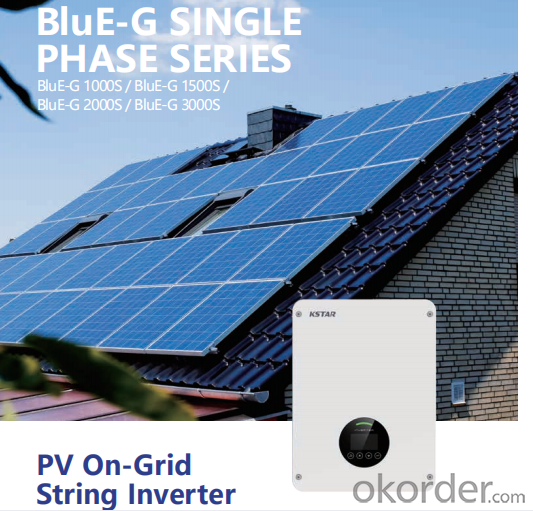
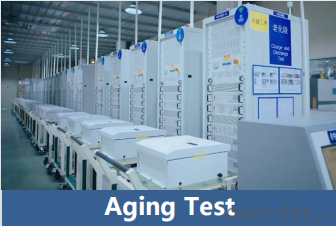
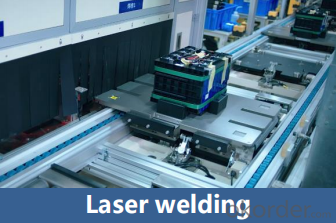
- Q: How efficient are solar inverters?
- Solar inverters are highly efficient, with most modern models achieving efficiency levels above 95%. This means that they can convert a large majority of the direct current (DC) electricity generated by solar panels into alternating current (AC) electricity for use in homes or businesses. The high efficiency of solar inverters helps maximize the overall energy output and financial benefits of solar power systems.
- Q: How does a solar inverter convert DC to AC?
- A solar inverter converts direct current (DC) to alternating current (AC) by using a two-step process. First, it takes the DC electricity generated by solar panels and passes it through a device called a rectifier, which converts the DC power into a high-frequency AC signal. Then, this AC signal is passed through an inverter circuit that converts the high-frequency AC into standard frequency AC, typically 50 or 60 Hz, suitable for supplying power to household appliances and the electrical grid.
- Q: What are the safety considerations when installing a solar inverter?
- Safety considerations when installing a solar inverter include ensuring proper electrical grounding, following manufacturer's instructions and guidelines, using appropriate personal protective equipment, avoiding contact with live electrical components, testing the system for proper operation before energizing, and complying with local electrical codes and regulations.
- Q: What is the role of a grid protection relay in a solar inverter?
- The role of a grid protection relay in a solar inverter is to monitor the electrical grid and protect against any abnormalities or faults that may occur. It ensures the safe and reliable operation of the solar inverter by detecting and isolating faults such as overvoltage, undervoltage, overfrequency, underfrequency, and other grid disturbances. The grid protection relay acts as a safeguard, preventing any damage to the solar inverter and maintaining the stability of the grid connection.
- Q: What is the role of a maximum power point tracker (MPPT) in a solar inverter?
- In a solar inverter, the maximum power point tracker (MPPT) plays a crucial role in optimizing the efficiency and power output of the solar panel system. Since solar panels generate direct current (DC) electricity while most appliances and the electrical grid operate on alternating current (AC), the MPPT continuously adjusts the operating conditions of the solar panels to extract the maximum power available from sunlight. The MPPT tracks the maximum power point (MPP) at which the solar panels can efficiently generate the most electricity. This is vital because the output of a solar panel depends significantly on factors like temperature, shading, and the angle of the sun. To ensure maximum power output, the MPPT continuously monitors and adjusts the voltage and current of the solar panel system, keeping it at the MPP. It achieves this by dynamically altering the electrical load on the solar panels to find the optimal operating point. Additionally, the MPPT acts as a converter, transforming the DC power generated by the solar panels into the AC power required for appliances or for feeding back into the electrical grid. This conversion process involves adjusting the voltage and frequency of the electricity to match the requirements of the appliances or the grid. In summary, the primary function of a maximum power point tracker in a solar inverter is to optimize the efficiency and power output of the solar panel system, ensuring the extraction of the maximum amount of energy from sunlight and its effective utilization for various applications.
- Q: Can a solar inverter be used with a solar-powered water pump?
- Yes, a solar inverter can be used with a solar-powered water pump. The solar inverter converts the DC power generated by the solar panels into AC power, which is suitable for powering the water pump. This allows for efficient and reliable operation of the pump using solar energy.
- Q: How does a solar inverter handle islanding detection and prevention?
- A solar inverter handles islanding detection and prevention by continuously monitoring the electrical grid's stability. It utilizes anti-islanding protection mechanisms to detect any abnormal conditions, such as voltage fluctuations or frequency deviations, that may indicate the presence of an islanded grid. In the event of islanding, the inverter immediately disconnects from the grid to prevent energy feed-in and effectively isolate the solar system. This ensures the safety of utility workers, prevents damage to equipment, and helps maintain the stability of the overall electrical grid.
- Q: Can a solar inverter be used in remote locations?
- Yes, solar inverters can be used in remote locations. They are designed to convert the direct current (DC) generated by solar panels into alternating current (AC) that can be used to power electrical devices. Solar inverters are versatile and can be installed and operated in various settings, including remote locations where grid electricity is not available. These inverters allow for the utilization of solar energy in off-grid areas, making them an ideal choice for powering remote homes, cabins, or other facilities.
- Q: What is the maximum voltage input for a solar inverter?
- The maximum voltage input for a solar inverter typically depends on the specific model and manufacturer. However, in general, it ranges from around 600 to 1000 volts, with some higher-end models able to handle higher voltages.
- Q: How does MPPT improve the efficiency of a solar inverter?
- MPPT, or Maximum Power Point Tracking, improves the efficiency of a solar inverter by constantly adjusting the operating point of the solar panel to extract maximum power from the sunlight. It ensures that the solar panel operates at its maximum power point, regardless of changing weather conditions or variations in the solar irradiance. This optimization leads to higher energy conversion efficiency, maximizing the power output of the solar panel and ultimately increasing the overall efficiency of the solar inverter.
Send your message to us
PWM Solar Inverter PV On-Grid String Inverter Blue-G 1000S / Blue-G 1500S / Blue-G 2000S / Blue-G 3000S
- Loading Port:
- China main port
- Payment Terms:
- TT OR LC
- Min Order Qty:
- 50 pc
- Supply Capability:
- 15000 pc/month
OKorder Service Pledge
OKorder Financial Service
Similar products
Hot products
Hot Searches
Related keywords
